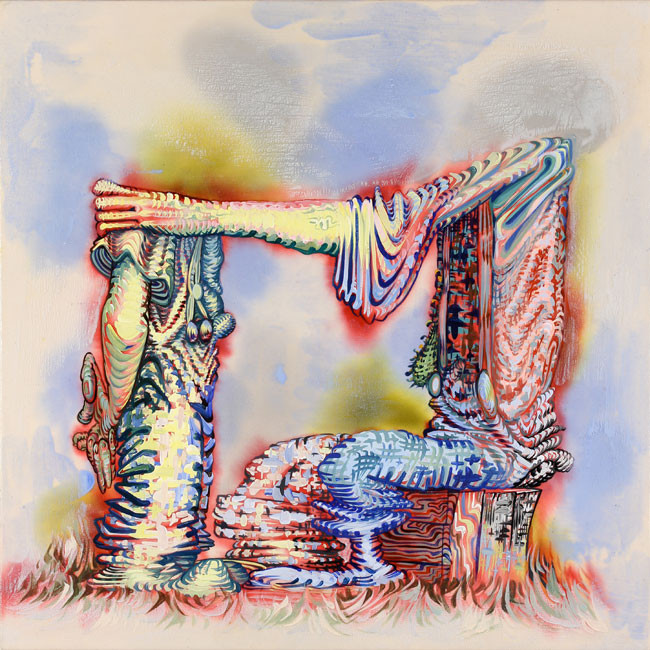James Esber
14 Nov - 31 Dec 2010
JAMES ESBER
You, Me & Everyone Else
14 Nov – 31 Dec, 2010
In his new work, James Esber continues to address notions of distortion and perception by mining the pawed-over icons of popular culture. His fourth one-person exhibition at Pierogi will include three new projects woven together in a two-room installation. In new paintings on canvas, Esber presents an array of visual puzzles; cutting, fragmenting and distorting found images before remaking them in calligraphic layered strokes of paint. These paintings invite the viewer to embrace absurdity or force a remedy by mentally bandaging holes and reconfiguring forms.
In Esber’s new work in plasticine, figures who have accidentally stumbled into the media spotlight are faintly depicted within heavily textured and undulating surfaces. The new pieces are meant to change drastically during the course of a day, their subjects surfacing and retreating into shadowy clay skins. The ghostlike quality of these images stands in stark contrast to the physicality of clay, and the pulsing nature of their presence and absence makes them seem alive. Teetering evenly between illusionism and objectness, these works are both permanent monuments to the individuals they portray and reminders that pictures are first and foremost objects whose recognition is subject to the vagaries of context and light.
For his third project, This is Not a Portrait*, Esber has enlisted a broad range of people (young and old, artists and non-artists), to translate his 2005 pen and ink drawing of Osama Bin Laden. Esber wants to “create an arena in which the distinction between skilled and unskilled hands is irrelevant and personal touch becames paramount. In the process of remaking every line, each participant may or may not be thinking about Bin Laden; the paper may be turned sideways or upside-down.” The final product is in no sense a conventional portrait. It is arguably not a portrait at all, but the re-presentation of a portrait image. Our emotional connection, or lack of it, effects how we relate to the work as both image and object. It is the question of connection, or perhaps the concession of disconnection, that ultimately becomes the subject.
James Esber’s work will be featured in a one-person exhibition at The Aldrich Museum opening January 2011. He received his BFA at the Cleveland Art Institute and studied at Skowhegan.
*Titled after Magritte’s La Trahison des images (Ceci n’est pas une pipe).
You, Me & Everyone Else
14 Nov – 31 Dec, 2010
In his new work, James Esber continues to address notions of distortion and perception by mining the pawed-over icons of popular culture. His fourth one-person exhibition at Pierogi will include three new projects woven together in a two-room installation. In new paintings on canvas, Esber presents an array of visual puzzles; cutting, fragmenting and distorting found images before remaking them in calligraphic layered strokes of paint. These paintings invite the viewer to embrace absurdity or force a remedy by mentally bandaging holes and reconfiguring forms.
In Esber’s new work in plasticine, figures who have accidentally stumbled into the media spotlight are faintly depicted within heavily textured and undulating surfaces. The new pieces are meant to change drastically during the course of a day, their subjects surfacing and retreating into shadowy clay skins. The ghostlike quality of these images stands in stark contrast to the physicality of clay, and the pulsing nature of their presence and absence makes them seem alive. Teetering evenly between illusionism and objectness, these works are both permanent monuments to the individuals they portray and reminders that pictures are first and foremost objects whose recognition is subject to the vagaries of context and light.
For his third project, This is Not a Portrait*, Esber has enlisted a broad range of people (young and old, artists and non-artists), to translate his 2005 pen and ink drawing of Osama Bin Laden. Esber wants to “create an arena in which the distinction between skilled and unskilled hands is irrelevant and personal touch becames paramount. In the process of remaking every line, each participant may or may not be thinking about Bin Laden; the paper may be turned sideways or upside-down.” The final product is in no sense a conventional portrait. It is arguably not a portrait at all, but the re-presentation of a portrait image. Our emotional connection, or lack of it, effects how we relate to the work as both image and object. It is the question of connection, or perhaps the concession of disconnection, that ultimately becomes the subject.
James Esber’s work will be featured in a one-person exhibition at The Aldrich Museum opening January 2011. He received his BFA at the Cleveland Art Institute and studied at Skowhegan.
*Titled after Magritte’s La Trahison des images (Ceci n’est pas une pipe).

